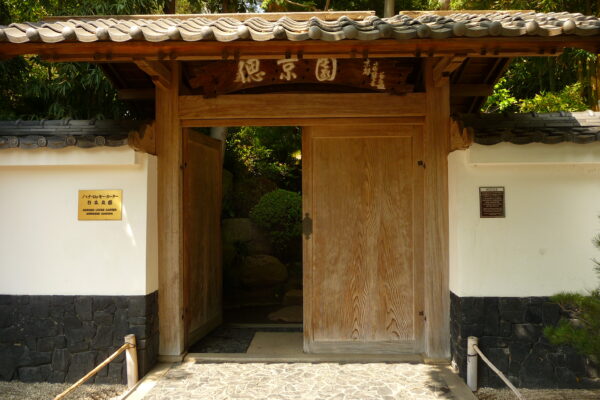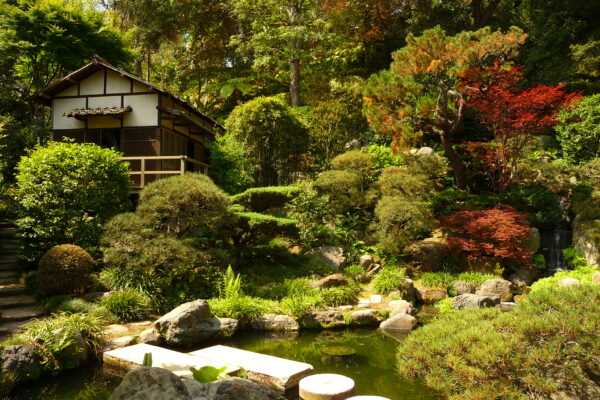
Place
Ethel Guiberson/Hannah Carter Japanese Garden
Called one of the largest and finest Japanese gardens in America, the Ethel Guiberson/Hannah Carter Japanese Garden evolved to become a traditional Japanese-style garden that has graced its hillside in Bel Air since 1961.
Saved
From 2011 to 2017, the Ethel Guiberson/Hannah Carter Japanese Garden was at risk and ultimately received protection through local designation and a legal settlement agreement.


Place Details
Address
Architects
Year
Style
Decade
Property Type
Government Officials
Community

Adrian Scott Fine/L.A. Conservancy
Overview
Beginning in 2011, longtime steward and owner, UCLA, announced plans to sell the Ethel Guiberson/Hannah Carter Japanese Garden and adjoining property containing the 1938 Shepherd Residence. This sparked a large community outcry that led to the establishment The Coalition to Save the Hannah Carter Japanese Garden in January, 2012, of which the Conservancy was a member organization. Through various efforts of the family of Hannah Carter and the work of the Coalition, the garden was ultimately saved in 2017 following designation as a Historic-Cultural Monument (HCM) and a legal settlement (in 2015) by the family and UCLA that afforded a 30-year protective covenant agreement.
While the garden is protected, there is unfortunately no public access as it is now privately-owned.
About This Place
About This Place
The Ethel Guiberson / Hannah Carter Japanese Garden is a traditional Japanese-style garden that has graced its hillside in Bel Air since 1961.
Its origins are actually even earlier, as the site first contained a Hawaiian-inspired retreat designed by landscape architect A. E. Hanson for Harry Calendar.
Gordon Guiberson later purchased the property and commissioned landscape designer Nagao Sakurai to create a Japanese-style garden below his residence. Sakurai was well known for designing the Imperial Japanese Gardens for the Japanese government at the Golden Gate International Exposition in San Francisco and World’s Fair in New York in 1939, and immigrated to the U.S. in the 1950s. He collaborated with Kyoto garden designer Kazuo Nakamura on the design for the new garden, keeping some of Hanson’s elements and adding many others to create a landscape which has been called one of the largest and finest Japanese gardens in America.
Completed in 1961, the garden (then called Shikyeon) emphasizes water, stones, and evergreen plants in a naturalistic setting. It is sculpted into the hillside and employs natural cobbles and quarried stone to help shape features like waterfalls, ponds, and winding pathways. Bridges, a teahouse, an entry gate, a hokura (family shrine) and a pagoda dot the skillfully shaped landscape; some of the structures were actually built in Japan, dismantled, and then reassembled on site.
The landscaping is incredibly dense and features many Japanese species as well as appropriate native species, from mature trees to low shrubs, flowers, and lichens. A mudslide in 1968 damaged the garden, but UCLA employee and garden designer Koichi Kawana rehabilitated it back to its original condition and appearance.
The garden is also associated with the 1938 Shepherd Residence, which is located on the adjoining property.
The Fight to Save the Garden, 2011-2017
In November 2011, UCLA first announced plans to sell the Hannah Carter Japanese Garden, citing rising maintenance costs, deferred maintenance, and the lack of attendance due to limited parking. The money generated by the sale of the garden would be used to fund core academic programs.
Despite public outcry, the university listed the garden for sale at a minimum bid of $5.7 million. The sale did not include any requirements that the historic garden be maintained or preserved.
The decision to sell the garden follows a 2010 court decision that allowed UCLA to remove the “in perpetuity” requirement included within the original donation agreement for the garden in 1964. In January 2012 UCLA began removing some objects and artifacts within the garden, and placed the garden for sale in March of the same year.
Zoned agricultural, the one-and-one-half-acre hillside site could conceivably be redeveloped for a single-family residence, destroying the garden. Currently UCLA is not planning to sell the garden with any protective covenants or requirements calling for it to be maintained or preserved.
As a public institution, UCLA is required to accept the highest bid. The Coalition to Save the Hannah Carter Japanese Garden was formed following a public meeting on January 31, 2012 with concerned citizens, members of the Carter family, and representatives from UCLA.
Our Position
The Conservancy was part of the Coalition to Save the Hannah Carter Japanese Garden, working closely with The Garden Conservancy, the California Garden and Landscape History Society, and the Cultural Landscape Foundation, as well as other concerned organizations. Since the sale was announced, we have urged UCLA to ensure the preservation of and continued public access to the garden, as intended and envisioned by the Carter family.
The Coalition to Save the Hannah Carter Japanese Garden strongly believes that the garden should be preserved and can be successfully operated and maintained through a public-private partnership, rather than destroyed, a likely outcome had the sale proceeded as originally planned.
The following points summarize the Conservancy’s position:
- The Hannah Carter Japanese Garden is a nationally significant historic place. The one-and-one-half hillside garden is among the largest and most significant private residential Japanese-style gardens built in the United States in the immediate Post World War II period. It is also associated with two of the most prominent designers of Japanese gardens, Nagao Sakurai and Koichi Kawana.
- The Hannah Carter Japanese Garden was donated to UCLA in 1964 to be cared for and maintained in perpetuity; UCLA should have honored the donors’ intent and terms of the agreement. In September 2010, UCLA went to court to secure permission to remove the “in perpetuity” requirement within the original donation agreement for the garden. At the time of the donation, Mr. Carter agreed to allow UCLA to sell the adjoining residence in the future, clearly stating as his first priority that the money “be used in perpetuity for the maintenance and improvement of the Hannah Carter Japanese Garden.”
- Selling the garden to the highest bidder without any conditions or protections would have endangered the garden and severely limited its likelihood for survival. As a requirement for selling State-owned property, UCLA had to accept the highest bid, regardless of the planned use or intent for the site. Zoned agricultural, the one-and-one-half-acre hillside site could conceivably be redeveloped for a single-family residence, destroying the garden. As part of the settlement agreement between the Carter family and UCLA, a restrictive covenant was placed on the property for a period of 30 years, set to expire in the year 2046.
- Gardens and other significant landscapes in Los Angeles and across the nation have been successfully operated, maintained, and preserved through private-public partnerships — all while serving educational purposes. Throughout the five-year effort to attempt to save the garden and maintain public access, UCLA did not reached out to garden, conservation, or potential friends groups to explore potential partnerships. Despite possible collaborations with Japanese studies and viable strategies to address long-standing parking issues, UCLA claimed the garden “serves no academic purpose” and using it “for any public functions is highly problematic.”






